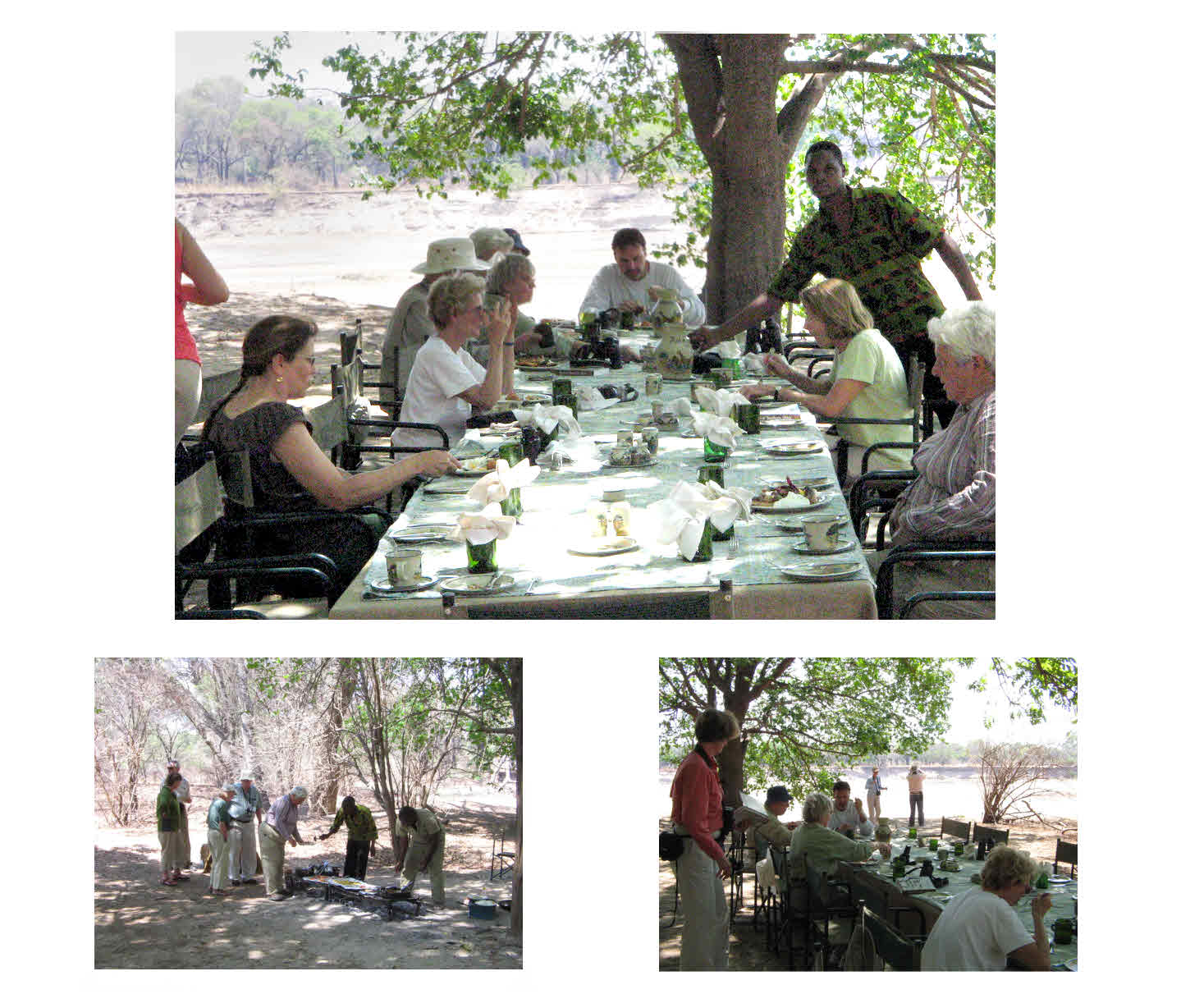

© TK Boyd 11/08
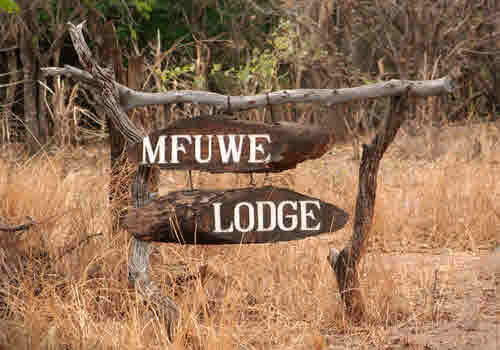
30 October: Arrived Mfuwe in the late afternoon after "interesting" journey from Chitabe. Landed at Mfuwe International Airport, with it's great long strip which you can see easily on maps.google.com, and were met by Land Rovers from the lodge. I was in the second party, and arrived at Mfuwe in the late afternoon. The first party's bags had arrived with us... I expect they had some anxious moments at the airport when their bags didn't arrive with them. We'd had a fantastic game drive on the way to departing from Chitabe, so being in the second party was no disadvantage.
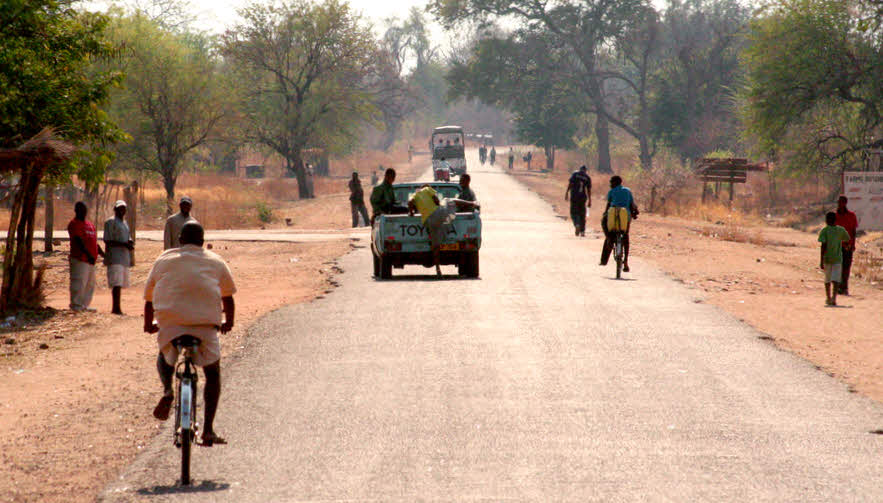
The lodge is one of the few (the only?) inside the South Luangwa National Park. We had an interesting 45 minute drive to the lodge, passing by the build-up of people along the road leading to the park, and passing over two splendid bridges. There was no water, yet, beneath one, but the riverbed was impressive. It would be fun to come back after the rains have come, but wild-life is harder to see then, as it has dispersed away from the limited water of the dry season. (There were sections of the road which were more built up that the stretch shown in the photo to the right.)
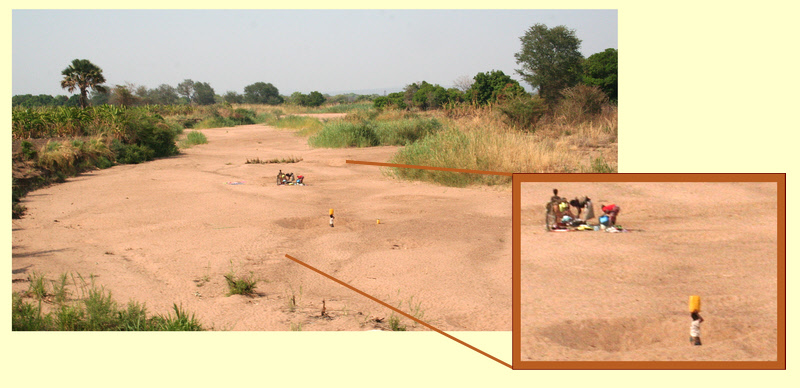
© TK Boyd 11/08
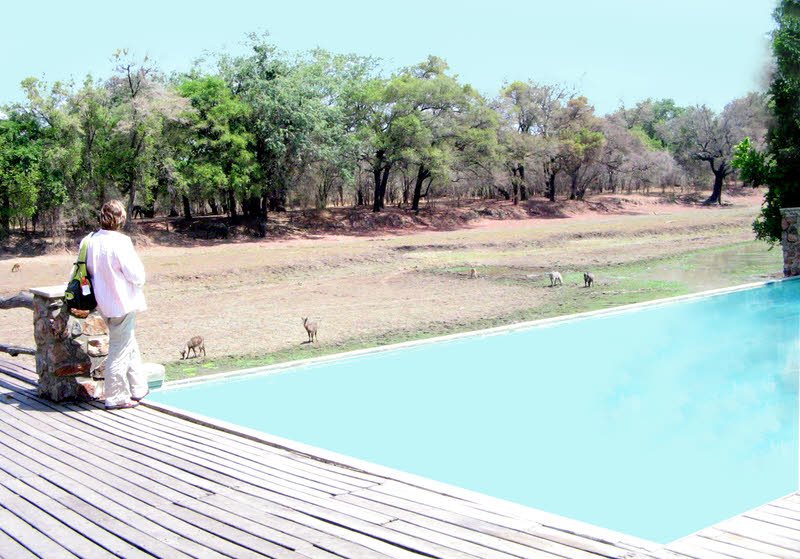
The facilities at Mfuwe are more extensive and more permanent than they were at Chitabe. Just as well, seeing as elephants regularly walk through the main lobby... more on this later.
The communal areas are on a bank above a large tributary of the Luangwa River, one of the major tributaries of the Zambezi River. At the time we were there, the river bed was dry, apart from a trickling channel of no more than six feet. To the right you can see the pool, which was very welcome in the hot middle of the day. From it, or the main deck beside it, you could enjoy the always changing pagent of wildlife in the almost dry riverbed below. The drop from the deck to the riverbed was perhaps 20 feet.
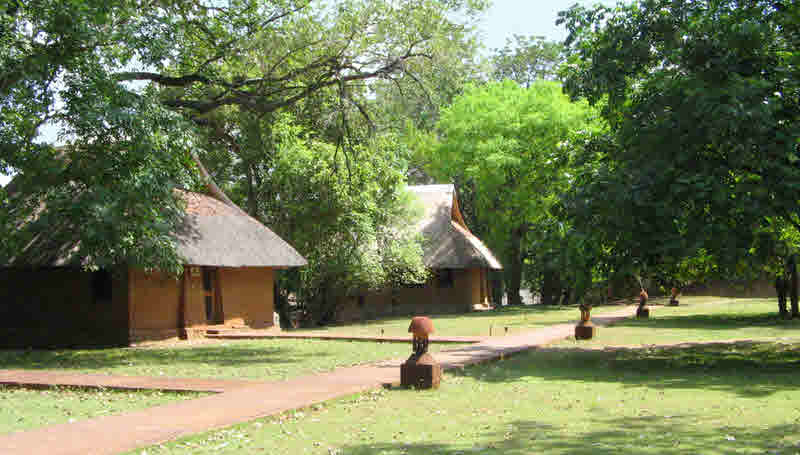
This is looking south from the main lodge area. What you see are a few of the luxurious guest chalets. They, like the main lodge, are perched above the river. Each has it's own private deck. Even in the midst of luxury, though, the wildlife was not far away. Hippos and other things made the area dangerous at night; we were instructed not to go to our chalets un-escorted. Even during the day, due deference had to be show to the occasional wild elephant wandering the grounds.
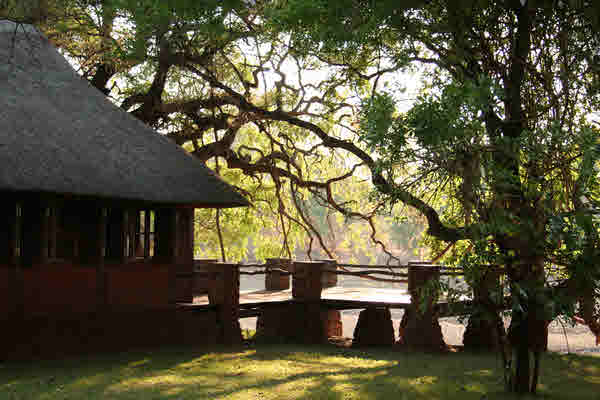
This is a view towards the east of one of the chalets in the previous photo.
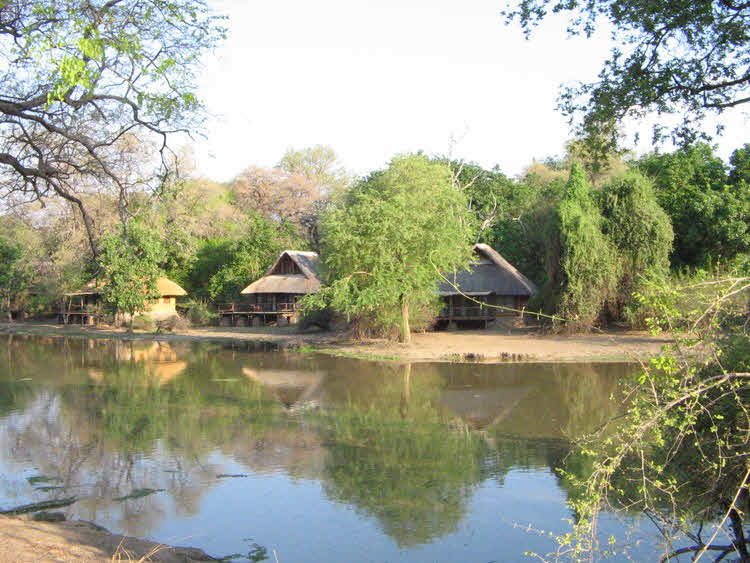
Behind the chalets you see here is the area shown two photos ago. These chalets face west. Others of our party stayed here. The pool these overlooked was home to a number of hippos, Africa's most dangerous animal.... which usually came out of their pool at night and visited the lawn between the two rows of chalets.
(There's a map of the site in the Elephants At Mfuwe Mango page, which we'll come to later.)
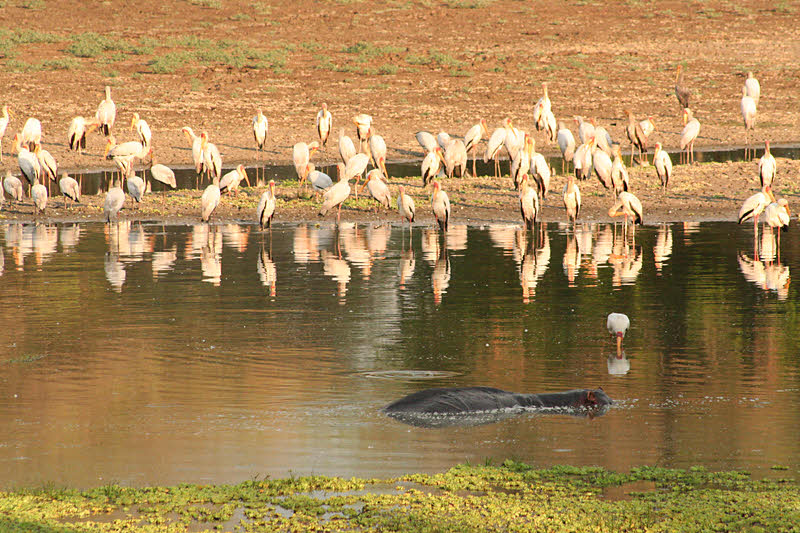
(The same pool, another time. Yellow billed storks (and hippo))
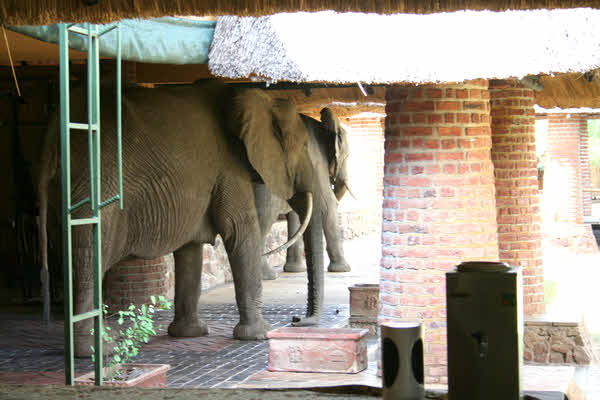
31 October: Our first full day at Mfuwe. The lodge has an amusing "feature", and we were visiting at just the right moment in the year to enjoy it. There's a large mango tree that, when in fruit, the elephants visit regularly. The interesting element in all of this is that one route to and from the tree is through the lodge's lobby. One family of elephants in particular were regular visitors. More on this later. The photo shows the matriarch, easily recognised by the unusual reverse curve to her right tusk.
These were wild elephants, not accustomed to having to ask anyone's permission to do anything. When they came for mangos, things had to stop; the operations of the lodge had to work around the wants of the elephants. They visited many times while we were guests. They have their own page, where you can enjoy them in detail.
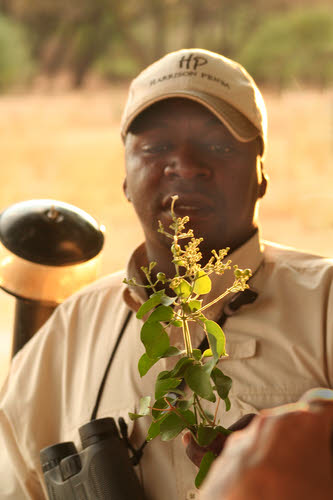
This is Jason, our guide and driver at Mfuwe. He's showing us some wild jasmine.
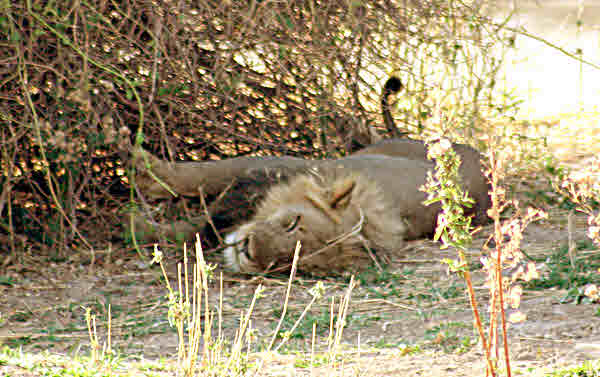
Early in our first drive, he found us this lion... doing what lions spend up to 23 hours per day doing... especially the males. Notice that he is gracing us with a stretch... quite active, by lion standards.
Yes- of course they are magnificent beasts.... but best viewed care of the great wildlife photographers who spend hours lying in wait to capture moments of interesting behaviour. Now cubs are another story. They can be quite entertaining. Don't think the lions never did anything for us, though... more anon...
Our first morning's game drive ended with a spendid main meal on a high sandbank above the river.

Mfuwe lodge, in addition to the usual local staff, also employed a startling number of delightful, bright, capable young ladies from Britain who were constantly finding ways to make guests day more agreeable. With such an opportunity, I couldn't resist presuming to ask one of them if she could persude chef to do a piece of fried bread for me, and she was able!
I said they were very capable. One recounted her experience the previous week: She was managing one of the "under canvas" satellite camps. A neighbour called on the radio in respect of a poacher active nearby. By the end of the evening the poacher was handcuffed to the camp's kitchen table while the lodge guests, unaware, continued their wilderness experience.
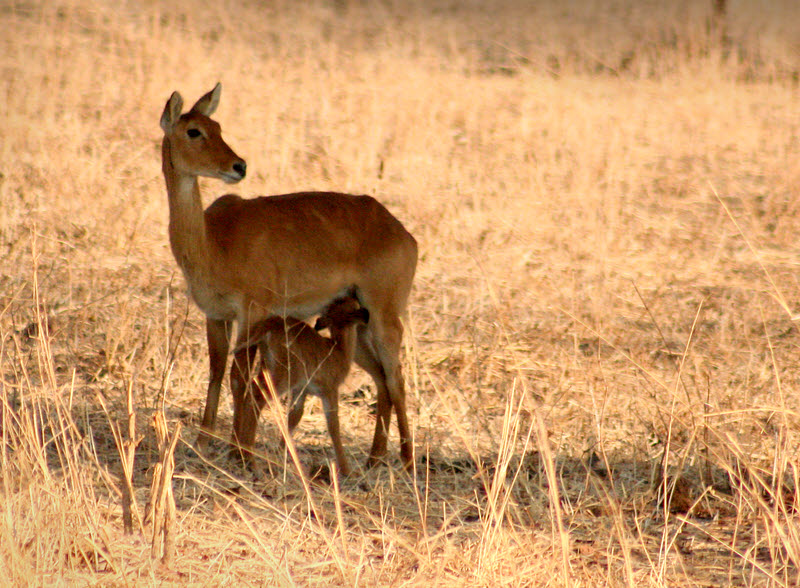
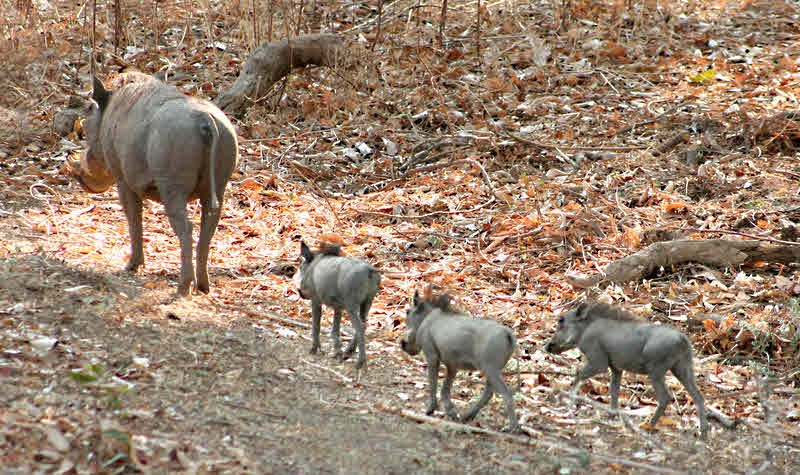
A word about the seasons. We visited at the end of the dry season, just before the rainy season, on purpose. (In fact, the Okavango has, in effect, two "rainy seasons".... but that's a story for another time.) When the dry season ends isn't set in stone, and our rooms were booked many months ago... and we got lucky. Things were still sufficiently dry to drive the game to the limited waterholes, but some rain had come, and some leaves were beginning to sprout. And animals were beginning to give birth. The impala is more than a little clever... if the rains are late, a normally seven month gestation can be stretched to nine months. And, even more clever, in a bad year, the near- full- term foetus can be reabsorbed by the mother! Happily such dire resorts were not necessary this year. Our guide was delighted to be able to show us the first baby impalas of 2008 while we were there.
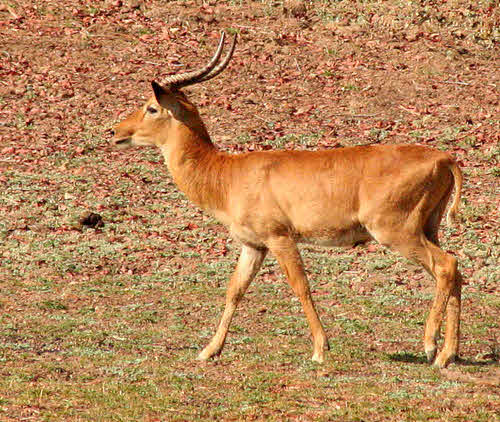
In fact, the antelope with young, above, while similar to an impala, is a puku... quite a rare beast with a limited range. We saw plenty of warthogs, always charming and "busy" little creatures. And to the right is a male puku, quite similar to the red lechwe which we saw in the Okavango, and perhaps in Zambia, but I find no note of a Zambian sighting.
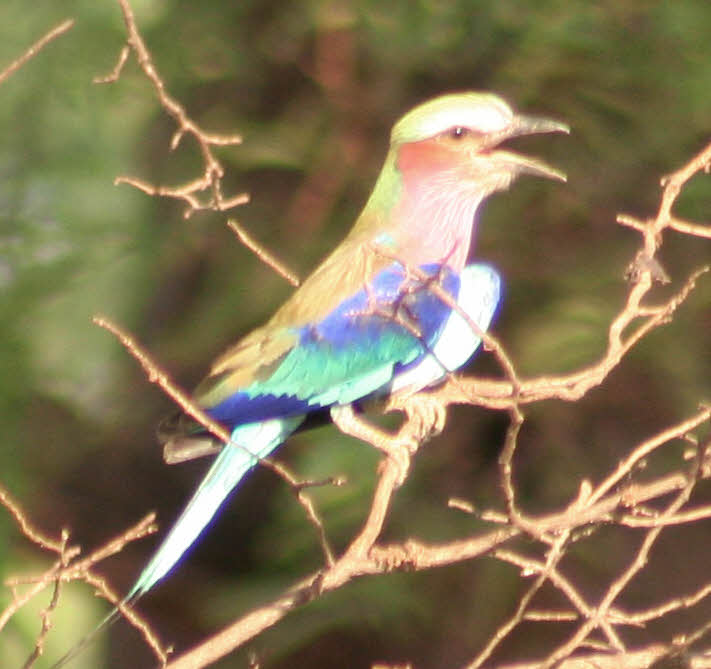
(Another lilac breasted roller)
The daily routine at Mfuwe was similar to that at Citabe. We had a "very expensive" extra half hour in bed in the morning. I say "expensive" because it wasted 30 minutes of prime game driving and photography time, but I can also say that this is the first major trip I've come back from for some time without having a minor health collapse on return.
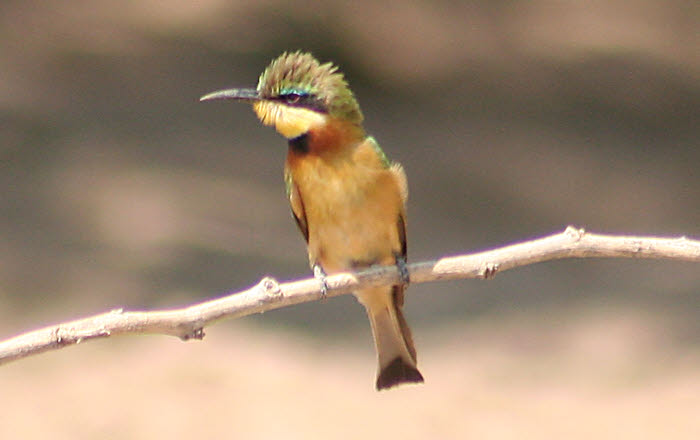
Speaking of health, one downside to travel to a tropical land: As ever, I got a number of insect bites. One of the consolations of return to my "real world" is that they soon fade, stop itching.
On the first of November, we left the national park to visit some of the local humans. This was in three parts....
(Bird: a bee-eater)
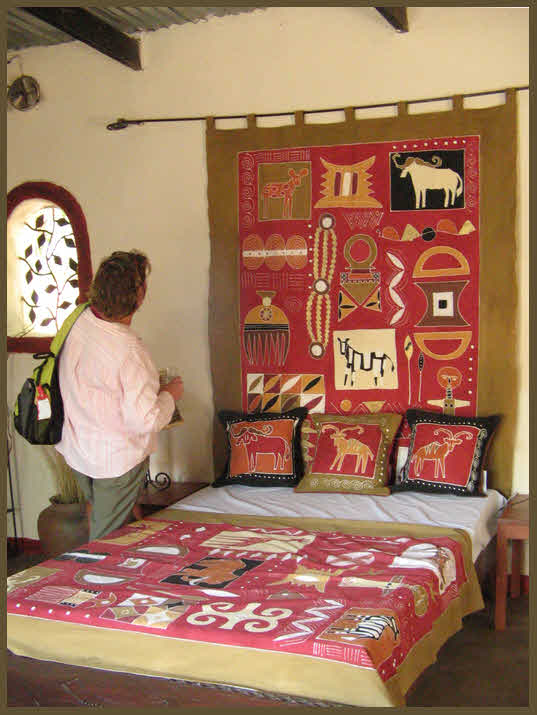
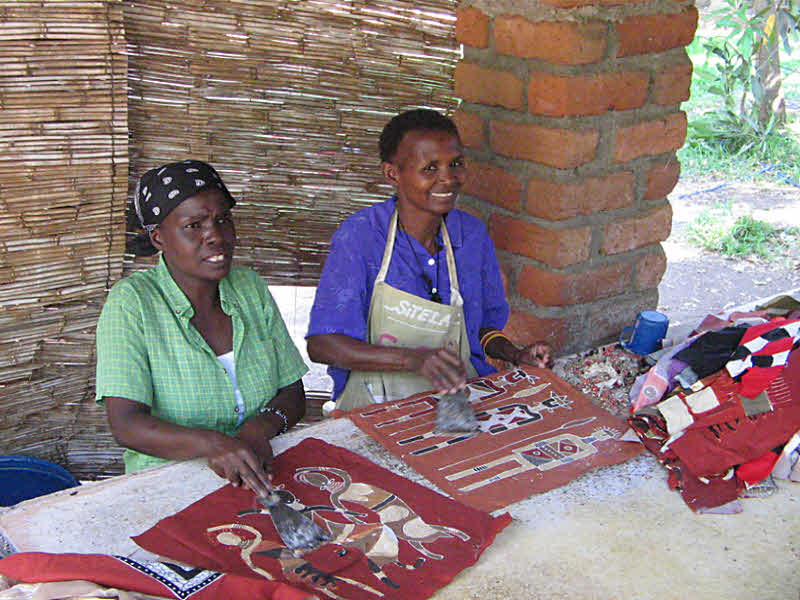
All on one quasi-Victorian site, we saw bolts of plain cotton(?) fabric and five paints (black, white, red, blue, yellow) turned into wonderful finished goods. And we had a tour of all phases of the process. I'll try to come back and expand this section, as the technology fascinated me.
The factory produced a wide range of products, from cushion covers to placemats, and there was more variety of style than the photos suggest.
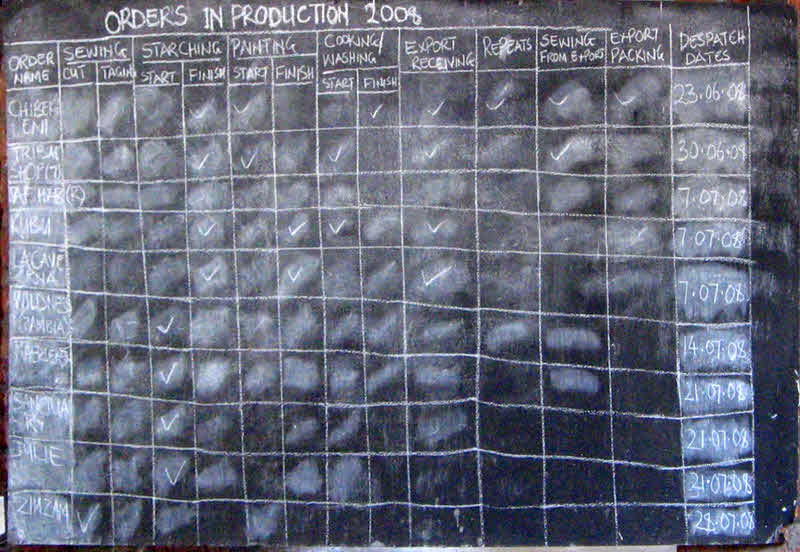
I say "quasi-Victorian" in admiration, not contempt. The working conditions were good, but un-necessary electronics were minimal, although there were a few PCs at work in the accounts department. On the factory.... several large, open, airy structures... floor, this is the sort of spreadsheet that was commonly present to help workers see how things were going.
I may have imagined it, but I sensed some of the best aspects of Marxism in the management style. There seemed to be an element of "production owned by the worker", if only in the sense of the workers seeing the operation as "their" factory. Managers with ties and clipboards were not evident. And there was a "thought for the day" on a blackboard:"'Had I known...' is the complaint of a fool." Several times, particularly in Zambia, I came across an admirable "old fashioned" sense of moral imperative. Our elephant driver, for instance, spoke quite seriously about his duty to know his elephant so well that he could anticipate anything that was going to arise. The people at the factory seemed more committed than wage-drones I've seen in other jobs in other, "advanced" places.
One of the senior guides at the lodge was also the headman of his village of about 150 souls. (The boundaries of the village weren't obvious to my "outsider's" eyes. It was part of the build up along the road between the park and the airport.)
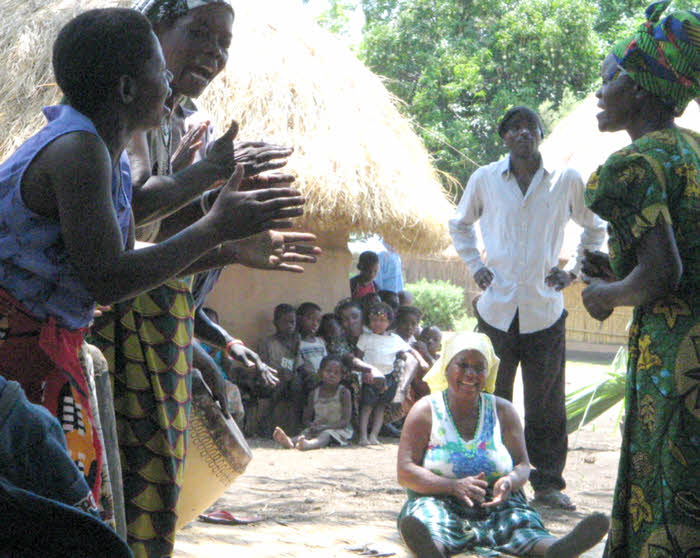
We were invited to visit "the village". What we were treated to first... and it was a treat... was a visit to a freshly built group of seemingly authentic huts, enclosed in a "I didn't see it elsewhere" "fence" of rushes. Think Williamsburg or Sturbridge Village (or Singleton open air museum) on a smaller scale. Very well done... but not "the real life of the people." We were also treated... and it was a treat... to some good dancing. But a bunch of local kids... it was Saturday afternoon... was forced to sit and make a backdrop for the event. They looked about as thrilled as a similar group back home doing a geography test in school.
Happily, after the performance, and some presentations about aspects of village life, things got a little more relaxed, informal. Some of the kids were becoming professional beggars... unfortunate, but inevitable. Several times I met examples of the old truth that the first answer you get to a question isn't always the only answer you get. On one level, we were told that education through about 14 years old is free and universal... and yet we saw and heard things that suggested otherwise. Do you have Aids orphans? No. And yet there was an Aids orphans hostel 1 km down the road from the "Disney" village.
By the way, I don't mean "Disney village" in a negative way. It was a commendable local initiative to utilize a market opportunity. Some of the dancers even appeared to be having some fun doing it. If you wanted to, you could even spend a night sleeping in one of the "native" huts!
As the visit to the Disney village was winding down, someone... thank you!... "dared" to slip through a gap in the fence to the real village the show village was in the midst of. And everyone else soon followed. This was much more interesting! The local "Bill Gates"s were, surprise, surprise... and deservedly so... were the park guides and rangers. The wild places will only remain so long as the local pople have a reason to protect their wildlife and trees, not eat/ burn them. The wealthier families had brick houses. But everyone was subject to the odd elephant raiding their gardens from time to time. (And you thought deer were a problem?) There was one asphalt road, the central artry of the local economy. Either side of it, the "asphalt" was well compacted red African dirt. Driving along the road, you didn't see some houses with BMWs.... but you could still see some houses which were raggity, and others where the yard was immaculate, stones had been set out to demark parts of the yard, etc.
Apparently someone in Lusaka has decided that Bricks Are Good. Not the brother-in-law of the chairman of the brick factory, I'm glad to say... we saw the clamps where bricks were locally manufactured factory-less... but I still have to wonder if bricks are really as suited to the local conditions as the traditional materials. I can see that tin roofs may have a place... although noisy in the rain, they don't get eaten by all the things that are always eating around here. In November 2008, there was still a goodly number of traditionally built structures in use. Commercial premises tended to be more solid. To permit locking up at night? And so the divide between rich and poor begins?
Ah well. Back to the less complicated world of the bush, I think.
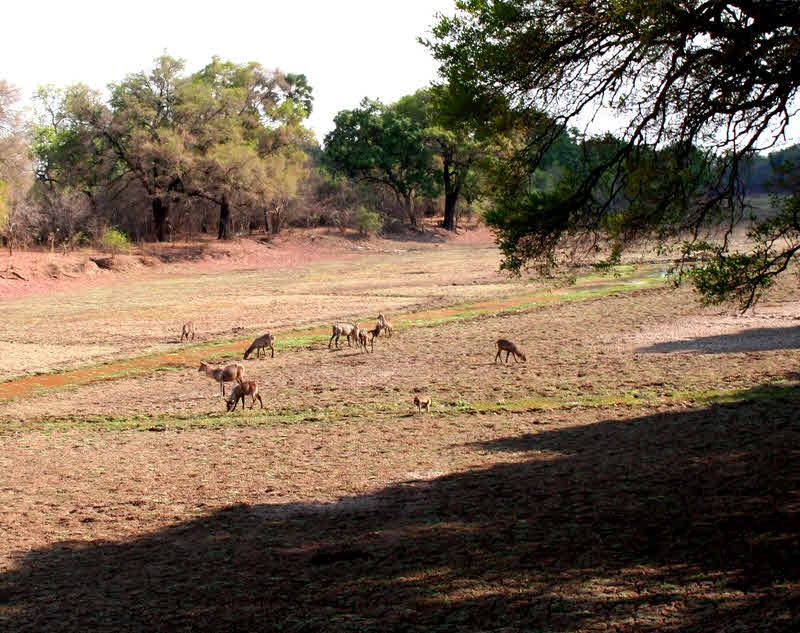
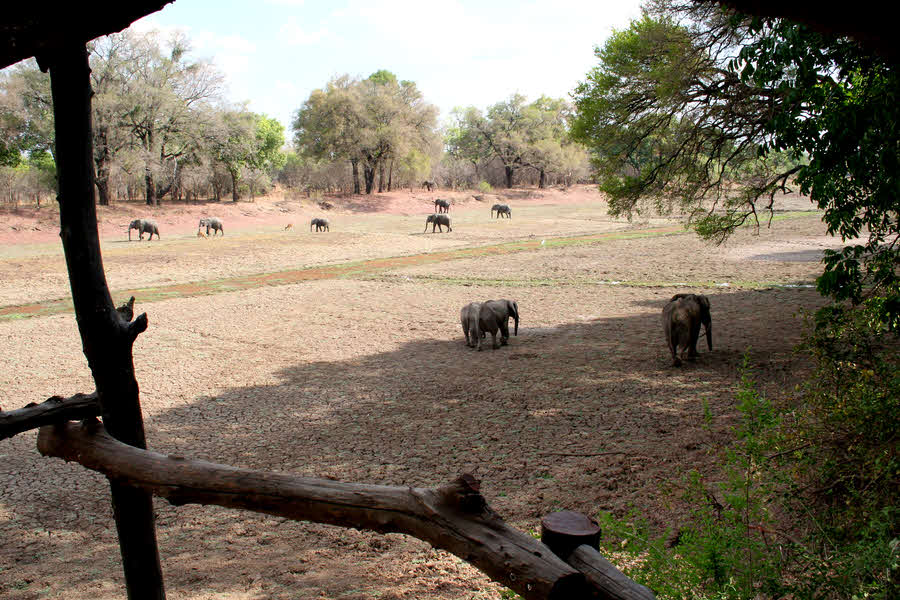
These are views from the porch of our chalet at different times. (Waterbuck in the left hand photo, elephants in the right hand one.)
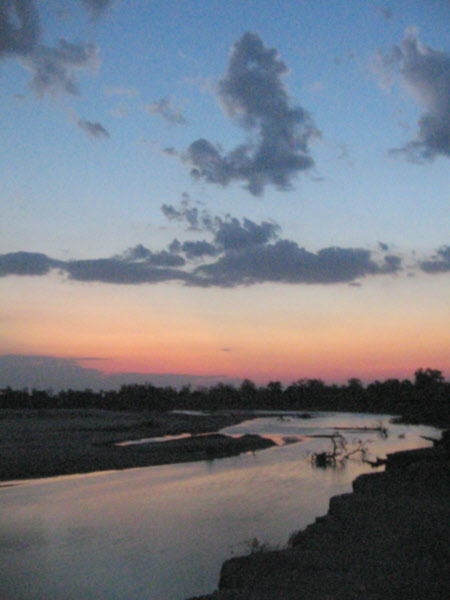
Our afternoon/ evening drive on November 1st encountered some dramatic weather. High and variable winds. Storms brewing on the horizon, but no rain "on our parade".
The weather led to a particularly fine sunset.
At Mfuwe, for the night drives, in addition to our morning guide/driver, we had a second person to operate the spotlight used to find animals, primarily by their eyeshine. (At Chitabe,, on (or off!) the much less maintained roads, the driver did everything! Drove. Spotted. Explained.
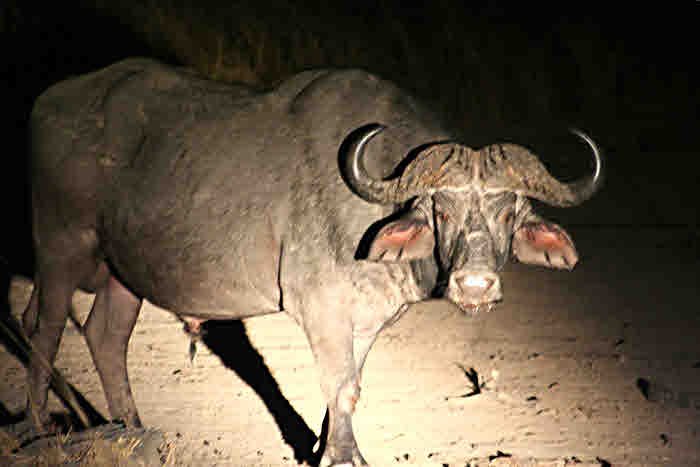
Not a gorilla. Not 800 pounds. Add about another thousand... he weighs roughly 1,800 pounds.
The name's the same, though. "Sir."
Our Mfuwe night drive November 1st was pretty exciting. First we encountered a "river" of perhaps 300 buffalo... A smaller group than we'd met in the daytime, and we weren't caught between them and a river this time. However, they weren't too happy about us and our lights. (Most animals didn't seem too bothered, especially when our guides took care to keep the light out of their eyes.) And you don't want buffalo to be unhappy, believe me. I'm pleased to report that before very long a gap opened up and we were able to "cross the river" and go on about our business and let them pursue theirs in peace.
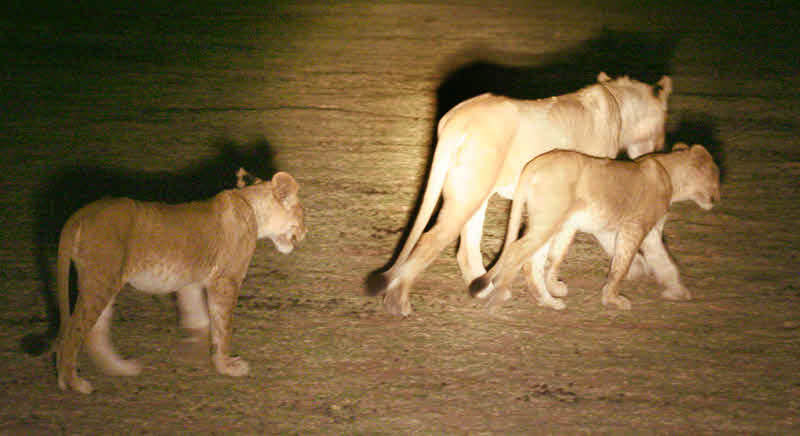
This drive also gave us our best lion encounter. We'd had a good drive, but our drivers / spotters seemed determined to find one last thing as we got near to being back at the lodge. They were crossing and re-crossing one particular area. I saw Jason and another driver agree "You go that way; I'll go this". And a moment later, as we came around a bush into a more open area, Bingo! An adult female lion. And she was on a mission. Totally ignored us and our lights. (The other vehicles soon arrived, thanks to the wonders of radio.) She was striding along. Not in any particular hurry... but very purposeful. I think she had a particular area where antelope spent the night in mind. And by luck we'd arrived at the right spot at the right time to see the vanguard of the parade.
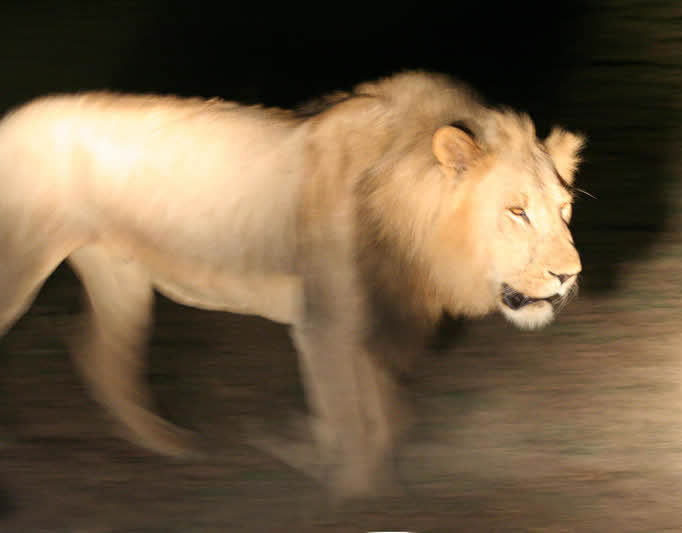
No sooner had we gone "ooo" as the first adult female passed us by at a range of maybe 20 feet than her adult sister came along, also on a mission. Next were an adolescent male and female. Following them, three cubs, messing about, as cubs do. And, after a suitable gap, Himself, the pride's male. Probably the lion we'd seen sleeping by the river on our first day.
We'd stopped in a good spot alost as soon as we saw the first female, and the lions weren't going to waste their time re-routing themselves just 'cause we were there. Some passed less than a simple "pounce" from us.
Speaking of pounces... Remember I told you that the BBC whetted my appetite with live video of lions in the night shortly before our trip? In that was a very funny sequence, filmed in infra-red. An adult lioness was creeping up on an oblivious antelope. At nearly the last minute, a cub launched a play attack on mom/ auntie... and the commotion tipped off the antelope, and the hunt was a bust. The adult looked peeved.
Also from that show were some thought provoking images of the pride lounging about in the grass not far from the BBC's camp. You could see the camp in the not- distant background of the image. Why not be close to the humans? It did make one wonder what was out there beyond our lights. My night vision scope (Bushnell) was well worth the not-much I paid for it on eBay, and it was high on the list of things that I was going to take, 33lb limit not with-standing. I had considered travelling with just one set of clothes, for the air journey... but then realised that the extra sunscreen I'd have to bring for "laundry days" would weigh more than a second set of clothes. Amazing what you don't need when you're only allowed 33lbs... including your carry ons! The next joke was when we were told not to have anything valuable (cameras, etc) in our checked bags out of Joburg to Botswana. And that we "needed" to declare any cameras, binocs, etc, in excess of $500 when entering one country. I had a suitable list, with serial numbers, etc, but elected to use the green channel when I saw that the red channel was un-manned, and used for storing surplus trolleys. (Customs are trying to prevent the untaxed import of things to be sold within the country.) Ah, the joys of travel!
Another little thing that amused me was watching a immigration officer playing chess online via Yahoo's games portal on his "check in the visitors" terminal. Some of these "third world" places haven't yet discovered the "joys" of undermanning things to the point that no one ever has any spare time, nor the "need" to tie employees hands. If Iris is down, the immigration queues at Heathrow take an hour or more. In Africa we rarely had to wait for people with clipboards. I didn't say we never had to wait! But not for people with clipboards.
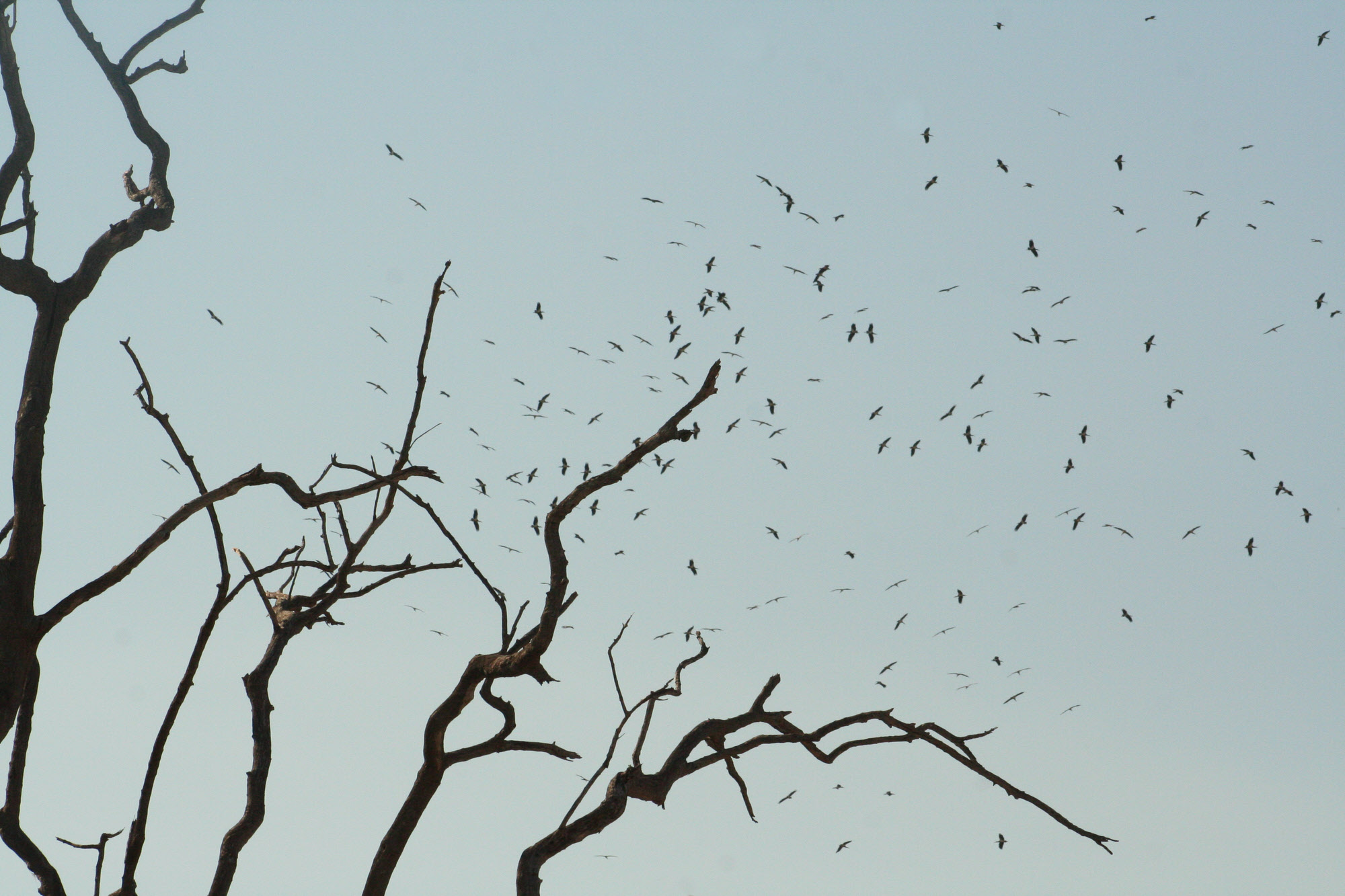
Going back to the night vision equipment: A dark red filter on a flashlight doesn't seem to ruin it's eyeshine-spotting powers, and the night vision scope "sees" the red just fine. (A "proper" flashlight, not one of the weak LED things that are sold now-a-days.) (And as a flashlight for normal useage, it doesn't ruin your night vision.) The BBC were using heat sensing equipment... looked like a video camera with a wide lens... but sadly these aren't on eBay yet. Fabulous images... not limited by the range of the IR lights, and much prettier to look at than the monochrome and "red-eyed" IR images we've had to date. Except for a slight loss of resolution, and the exotic colors, you would think that you were looking at a savanah by daylight. Besides the as-far-as-you-can-see range, the heat sensing camera has the advantage of highlighting mammals which you might overlook by daylight. (Their body heat makes them stand out.) If you go to the BBC Big Cat video library, you may be able to play the one called "New for 2008", to see the heat imager in action... although you have to wait through the first 70 seconds or so to get to the images. It would also be worth viewing any of the "Jackson" clips, to get an idea of how good the highly selected guides are. (If you find the clip of the cub wrecking the hunt, email me the clip's title and I'll update this page.)
Another way to find interesting things was to watch for vultures and storks. Here you see a large group of storks which were for some reason disturbed from what they were doing on the ground. This is more than would be attracted to a single kill. Either it is a night roost setting out for the day, or it is a group that were taking advantage of a pool on the riverbed which had concentrated many cubic meters worth of fish down to a small and easily harvested bonanza.... we saw several instances where shrinking waters had concentrated the fish to the point that their fins were appearing above the surface.
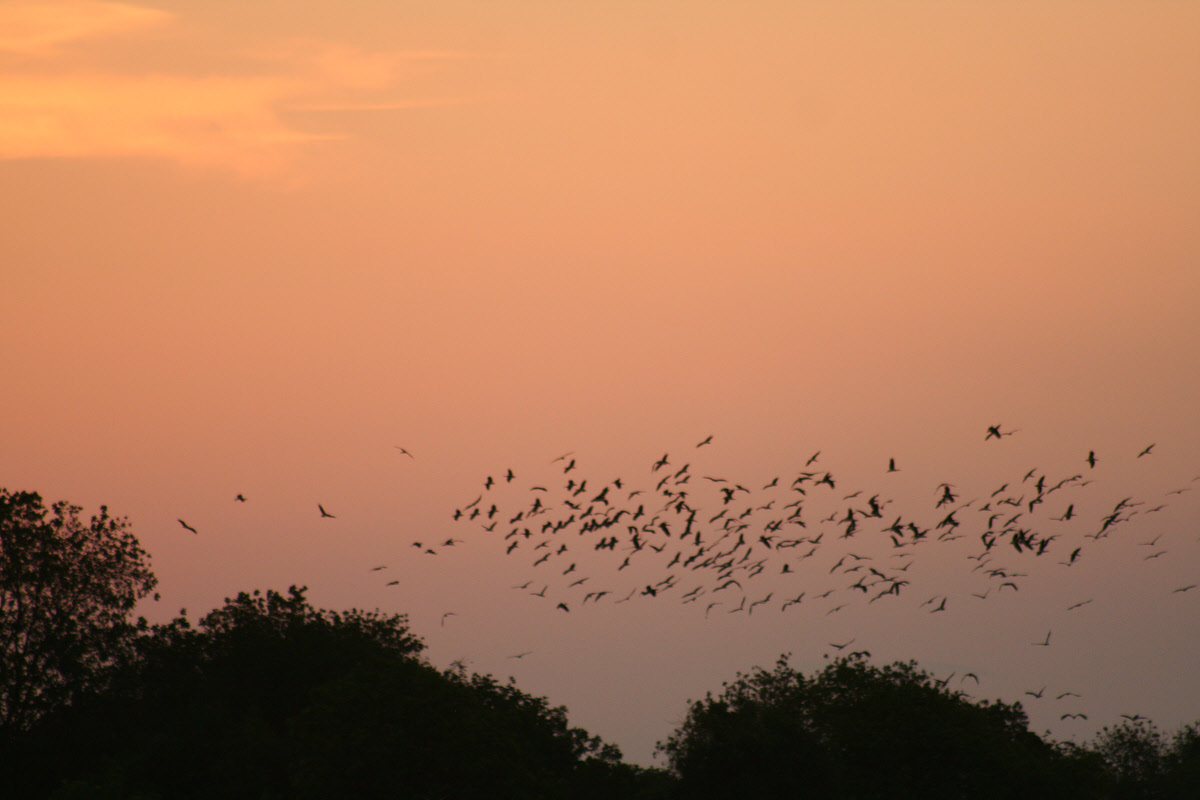
The sundowner on 2nd November was particularly fine. Again we were on a sandy bank above the river. The photo is of a large group of Abdin's storks. They follow insect infestations. If ever you want to master the concept that biology is all about eating and being eaten, visit Africa!
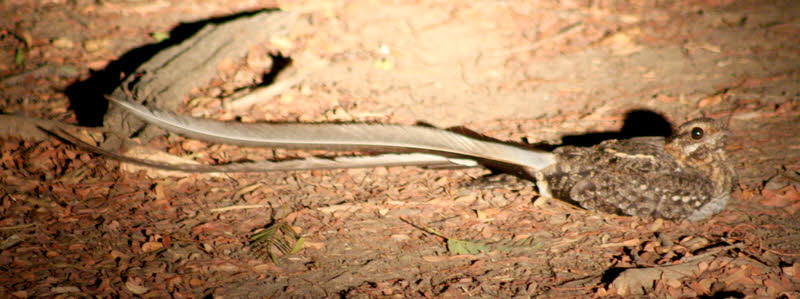
It was on the same night's drive- in- the- dark back to camp that we encountered the pretty little bird shown above, a pennant-winged nightjar (Macrodipteryx vexillaria), close cousin to the whip-poor-wills you may know. It is a nocturnal insect eater. I'd seen nightjars, resting on the ground like this, quite often other places, other times... but not one with the extraordinary plumes which are the reason for the photo being so wide. The rest of the bird, including it's "normal" tail, occupies only the right hand half of the photo. The two long plumes, one on each wing, are part of a glorious seasonal breeding plumage.
Seeing the bird resting on the ground, I'd assumed the plumes were tail feathers. Nothing I'd ever seen prepared me for the exquisite view we had of it in flight. The plumes are the least distal primary feathers.... i.e. feathers in the middle (left and right) of the wing. They are not stiff, and as the bird flaps its wings, the plumes undulate. It was all rather like the aesthetic "gymnastics" in which the performers flutter long strips of silk.
Poor JB was very jealous when he heard we'd seen one of these. There was some confusion at first, as we'd misunderstood Jason to say we'd seen a "peanut winged" nightjar.
My bird book's map has just a few speckles for the bird in Botswana, and describes it as "rare, status not established, very few records" (for Botswana, only just SW of where we saw it.) But maybe it is just in Botswana that it is rare. I'm pleased to report that the Wikipedia article lists it's status as "not of concern".
Creatures great and small?
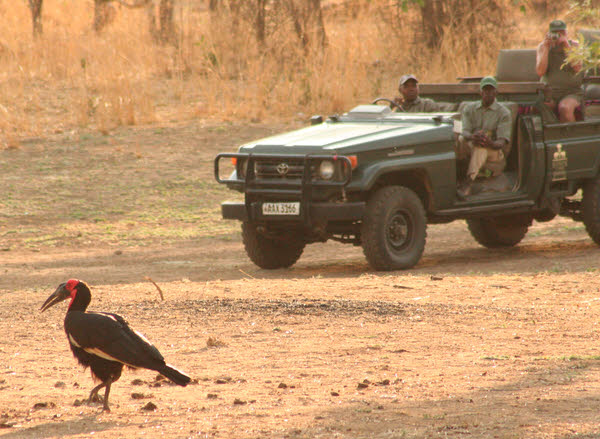
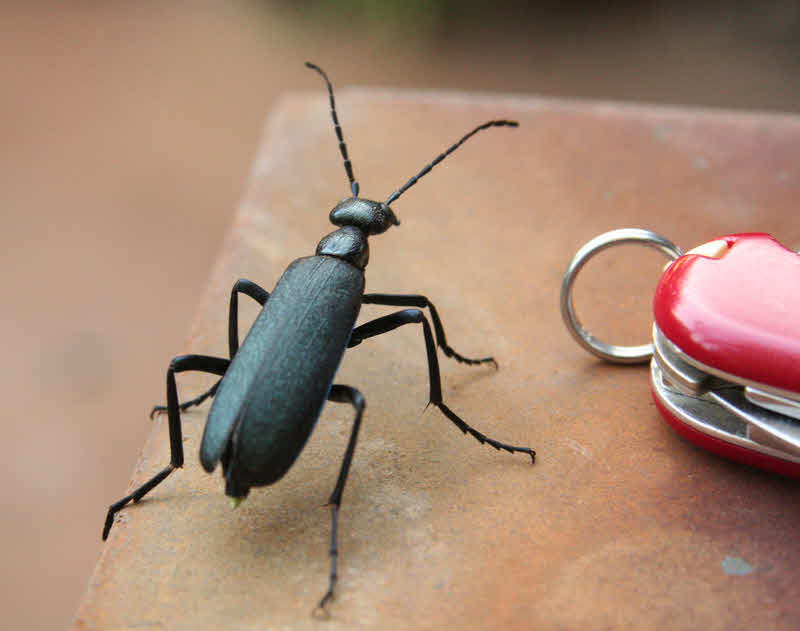
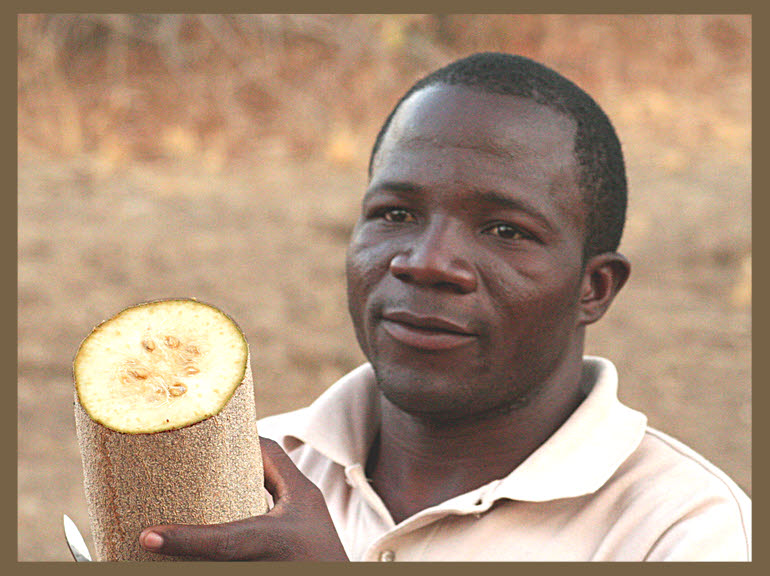
This is Stephen, our night drive spotlighter. He is showing a cross-section of a "sausage tree" fruit. (That's my trusty Swiss army knife at the lower left.)
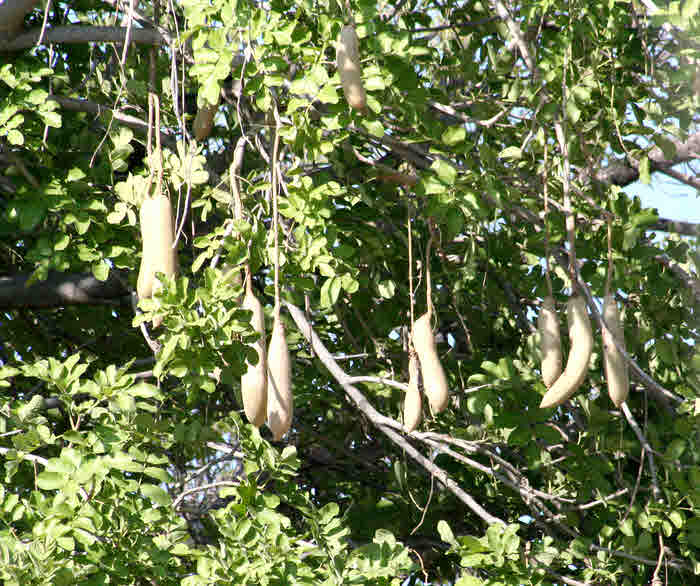
And to the right, a picture of the tree the fruit grows on. The flowers are rather splendid, too... a bit like corgette/ zuchini blossoms. The trees were quite common.
You really don't want to linger under a sausage tree. Those fruits are remarkably dense, and, as you can see from the one in Stephen's hands, not small. A big one might weigh 40 pounds. Not something to get yourself hit on the head by.
You can eat the flesh of the fruit, but it wasn't a special treat. Much more useful was it's anti-histamine powers. I had a nasty, itchy bite/ sting on my finger... just where my pen rubbed when I tried to write... and one quick wipe over the area with a bit of "sausage" worked wonders. The bite might well have been from a tsetse fly... don't let it be said that I'm not a "try everything" sort of tourist! By the way... a too light or bright shirt will hurt your chances of seeing some wildlife when you are on foot. And a too dark shirt attracts the tsetses. So now you know what to wear when you go.
OT, our Okavango guide, as related elsewhere, claimed that the fruit acted like a piece of toffee when a croc was tempted to chomp down on it, and enabled him and friends to pull the croc out of a river. As you probably know, while a croc's jaws close with a prodigeous force, the muscles for opening them are weak. Maybe the story was true.
That story reminds me of another I heard. A twelve year old was walking to school one day when his path crossed that of a lion. The boy was carrying a stick, and with it chased the lion off. The boy explained that his eith your old brother was with him, and he didn't want his brother eaten. One presumes that the lion wasn't very hungry, any more than the leopard who was seen off by the jackal, as related elsewhere.
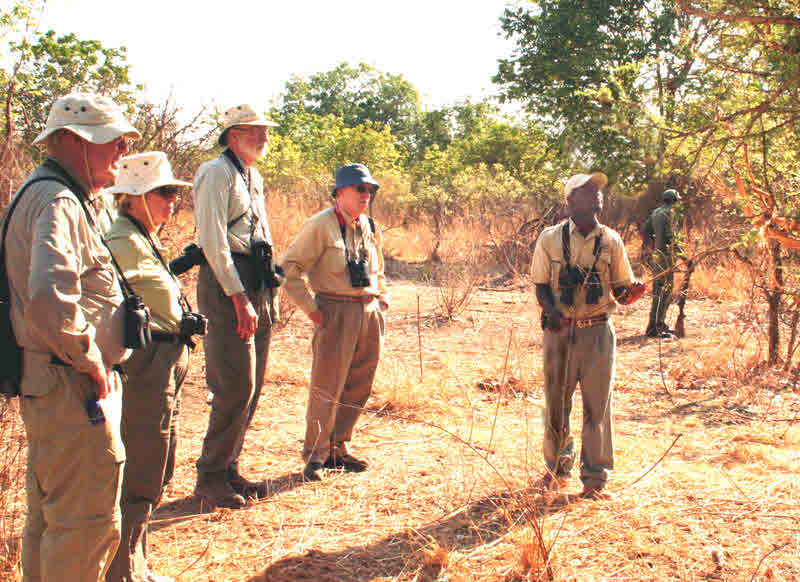
Which brings me neatly to our walk through the wild places on the morning of 3 November. If ever you travel to such a place, be sure to ask if walking is an option. Obviously, you can't cover as much ground, but the experience is much more intimate, and well worth seeking out.
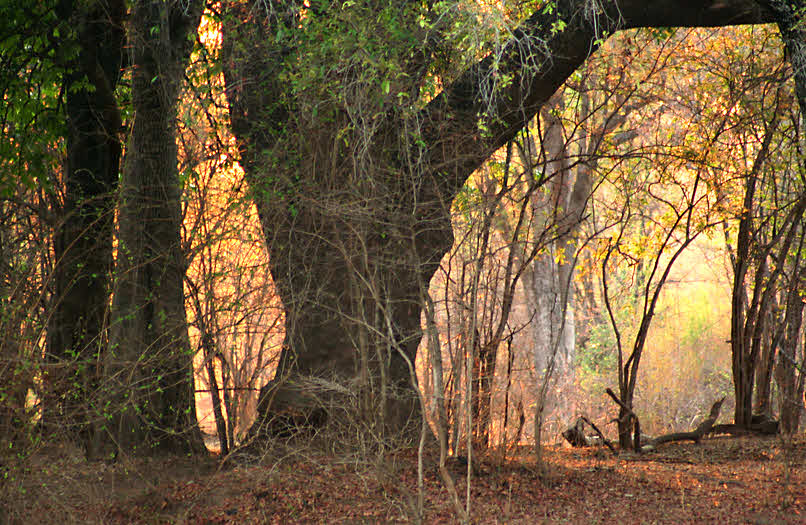
The tree in the photo was actually on the bank across the riverbed from our Mfuwe chalet, but it gives the atmosphere of our game walk.
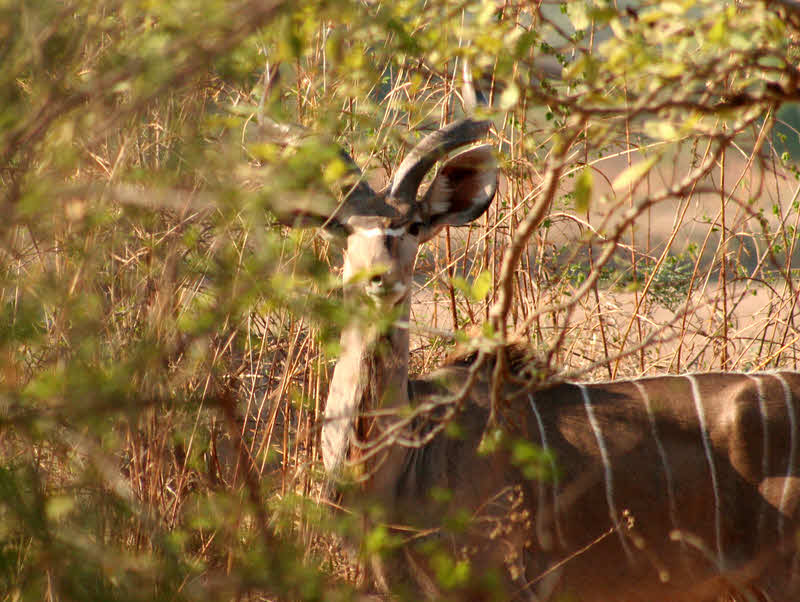
These two lovelys... waterbuck on left, kudu on the right... while not as abundant as the impala, were both animals we saw frequently. They are both quite a lot larger than the impala- hence in part the lower numbers. (50, 63 and 35 inches at shoulder, respectively, waterbuck, kudu, impala.) The waterbuck (surprise, surprise) liked wet places, and was often in groups of 10-20. The kudu was almost always browsing in some shady spot in a small group presided over by one male.
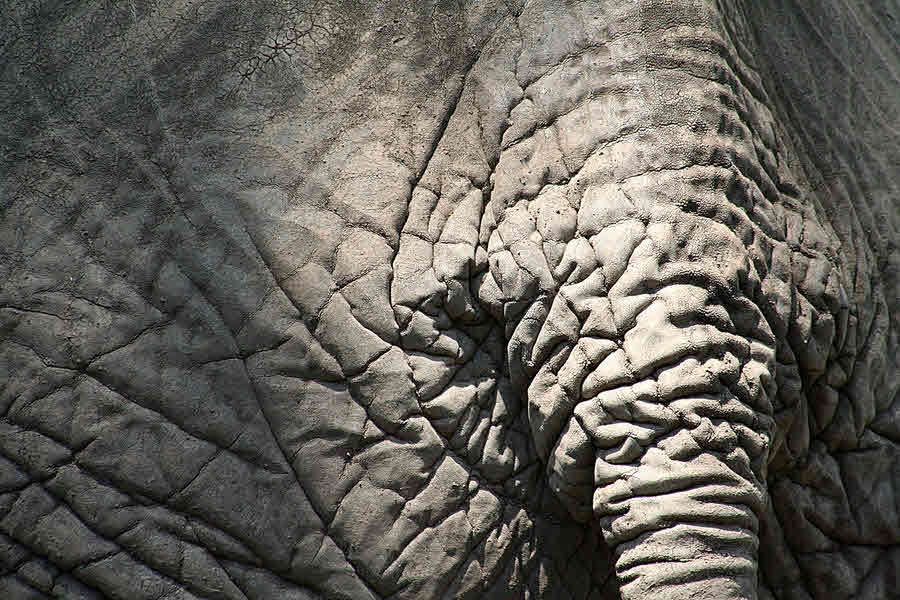
(of the Mfuwe, and "wild" part of the trip.... but visit the Victoria Falls "finale" page, too?)
© TK Boyd 11/08. Click here to contact him.